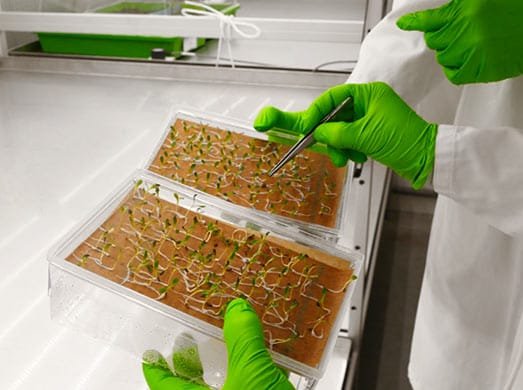Introduction

Seed is the basic input in agriculture, just like a foundation is essential for a strong building. Without good quality seeds, the productivity of other agricultural inputs like fertilizers, water, and pesticides becomes limited. Seed technology plays a crucial role in increasing agricultural production by ensuring that high-quality seeds are available, accessible, and adaptable to specific environments. Seed technology is the science and art of handling seeds beginning from the development stage, production, processing, storage, quality control, and distribution to farmers.
Summary of Seed technology
- Genetic purity and physical quality ensure seeds stay true to their variety, clean, and free from contaminants, building farmer confidence and improving crop performance.
- Maintaining seed viability and vigor through careful control of moisture, temperature, and storage conditions guarantees strong germination and healthy plant growth.
- Processing, testing, and certification apply scientific methods to deliver high-quality seeds that are safe, reliable, and ready for successful market distribution.
Table of Contents
Objectives of Seed Technology
Seed technology aims to produce, maintain, and distribute high-quality seeds of superior varieties so farmers can benefit from better crop performance. The main objectives include:
1. Production of genetically pure seeds
The goal is to ensure that seeds are true to the type of the original variety, without any genetic contamination.
2. Maintenance of seed quality
Seeds must maintain viability, vigor, and physical purity over time.
3. Distribution of quality seeds
Delivering good seeds at the right time and place in adequate quantities to farmers.
4. Introduction of improved varieties
Seed technology helps in the rapid multiplication and spread of newly developed varieties.
5. Increase in crop productivity
Better seed quality directly results in higher yields and better resistance to pests, diseases, and environmental stresses.
Principle of Seed Technology
Seed technology is based on certain scientific and practical principles. These principles guide the process of developing, maintaining, and distributing high-quality seeds. Below are the major principles explained in detail.
1. Genetic Purity Maintenance
Genetic purity refers to the true-to-type nature of the seed, meaning the seed should possess the exact genetic characteristics of the parent variety. This is crucial to maintain the identity, performance, and expected benefits of a particular variety.
a. Importance of Genetic Purity
Genetically impure seeds can lead to unexpected crop performance, poor yields, and susceptibility to diseases. Farmers may lose trust in the seed and the institution that produced it.
b. Methods to Maintain Genetic Purity
- Use of certified seeds for multiplication.
- Isolation of seed crops from other varieties during production.
- Rogueing or removal of off-type plants.
- Strict field inspections and monitoring.
- Maintaining proper breeder, foundation, and certified seed classes.
2. Physical Purity of Seeds
Physical purity refers to the absence of unwanted materials in seed lots, such as inert matter (soil, stones), weed seeds, broken seeds, and seeds of other crops.
a. Importance of Physical Purity
Physical impurities reduce the market value of seeds, affect seedling vigor, and introduce weeds into the field. Ensuring physical purity is a sign of seed quality.
b. Achieving Physical Purity
- Careful harvesting and threshing practices.
- Proper seed cleaning and grading.
- Use of advanced processing equipment.
3. Seed Viability and Vigor
Viability refers to the seed’s ability to germinate under suitable conditions. Vigor refers to the strength and speed of germination, as well as the ability to grow into healthy seedlings.
a. Importance
High viability and vigor ensure uniform germination, good crop establishment, and higher yields.
b. Maintenance
- Use of fresh and properly matured seeds.
- Adequate drying to safe moisture content.
- Proper storage in cool and dry conditions.
- Regular testing in seed labs for germination percentage and vigor index.
4. Seed Processing
Seed processing is a systematic operation that involves cleaning, grading, treating, and packing seeds to make them suitable for sowing.
a. Steps Involved
- Pre-cleaning to remove larger debris.
- Cleaning with air-screen machines.
- Grading based on size and weight.
- Seed treatment with fungicides and insecticides.
- Packing in moisture-proof bags.
b. Objectives of Seed Processing
- Improve physical quality.
- Enhance seed storability.
- Facilitate easy handling and transportation.
5. Seed Storage

Storage is one of the most critical components in seed technology. Seeds must be stored in conditions that maintain their quality until the next planting season.
a. Factors Affecting Seed Storage
- Temperature: Seeds should be stored in cool conditions.
- Humidity: Moisture content should be low to prevent fungal growth.
- Pests and rodents: Should be kept away through fumigation and good sanitation.
b. Storage Types
- Short-term storage for seasonal use.
- Long-term storage for gene banks and seed reserves.
6. Seed Testing

Seed testing involves the evaluation of seeds to determine their quality parameters such as purity, germination rate, moisture content, and health.
a. Importance of Seed Testing
- Helps in quality assurance.
- Prevents distribution of poor-quality seeds.
- Guides farmers in choosing the best seed lots.
b. Major Seed Tests
- Germination test.
- Moisture test.
- Purity analysis.
- Seed health test.
7. Seed Certification
Seed certification is a legally sanctioned process that ensures the genetic and physical purity of seeds produced and distributed.
a. Purpose
- To maintain the quality of seeds.
- To ensure that seeds meet minimum standards.
- To protect the interests of farmers.
b. Classes of Seeds in Certification
- Breeder seed.
- Foundation seed.
- Certified seed.
8. Seed Marketing
Seed marketing involves the planning, production, packaging, advertising, and sale of seeds to farmers.
a. Objectives
- Ensure timely availability.
- Create awareness among farmers.
- Promote new and improved varieties.
b. Challenges
- Price fluctuation.
- Competition.
- Lack of infrastructure.
9. Legal and Regulatory Framework
Seed technology is governed by several laws to maintain seed quality and protect the rights of all stakeholders.
a. Major Seed Acts and Regulations
- Seed Act.
- Seed Rules.
- Plant Variety Protection and Farmers’ Rights Act.
b. Seed Certification Agencies
These agencies are responsible for monitoring and certifying seed production according to national standards.
Conclusion
Seed technology is the foundation of modern agriculture, ensuring that seeds are genetically pure, physically clean, viable, and vigorous. At its core, the discipline revolves around maintaining genetic purity through careful field selection, isolation, and rigorous inspections. This prevents contamination and ensures that seeds remain true to their parent variety, giving farmers confidence in the performance of their crops.
Physical purity is equally essential, focusing on removing inert matter, weed seeds, and other impurities. Clean, uniform seeds promote strong seedling development and contribute to uniform crop stands in the field. After harvest, seed processing becomes critical. It involves cleaning, grading, and treating seeds to make them ready for storage and planting. These steps not only enhance seed quality but also prolong shelf life and ease of use.
Proper storage practices are vital to preserving seed vigor and viability. Seeds must be stored under cool, dry conditions to prevent moisture build-up, pest infestation, and deterioration. Seed testing further ensures that only high-quality seeds reach the market. Regular tests for germination, purity, moisture, and seed health provide essential data to farmers, producers, and regulatory bodies.
Certification adds another layer of quality control. By following a legal and structured process, it guarantees that seeds meet national and international standards. This system includes various classes of seeds, from breeder to foundation and certified, each playing a role in maintaining purity through generations.
Marketing and distribution connect the science of seed technology with farmers’ fields. It ensures timely availability of quality seeds, promotes new varieties, and educates farmers. A strong legal framework reinforces all these efforts by protecting intellectual property rights and ensuring accountability.
To sum up, seed technology combines scientific precision with practical systems to empower farmers, increase crop productivity, and support global food security. Its role will only become more vital as we meet future challenges in agriculture.
Frequently Asked Questions (FAQs)
What are the key principles of seed technology?
Seed technology is based on genetic purity, physical cleanliness, viability/vigor maintenance, processing, testing, certification, and structured distribution each essential for producing high-quality seeds.
Why is seed certification important?
Certification ensures seeds meet legal standards for purity, germination, and health, guaranteeing farmers reliable, high-performing seed.
How does seed processing improve quality?
Through cleaning, grading, and treatment, seed processing removes impurities, enhances storability, and readies seeds for uniform planting.
Related Articles

